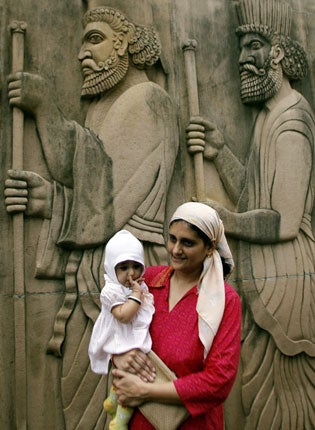High rate of cancer puts Parsis under microscope

Neville Wadia was only a child when his parents sat him down and told about the deadly disease that plagued his community.
“I was seven years old and my father’s brother, who was living in Australia, got cancer. So it was all explained to me,” said Mr Wadia, a member of Mumbai’s Parsi community who recently cycled from Bangalore to raise money for cancer care. “Later, I came to realise how it affected the community.”
The Parsis of India, followers of one of the world’s oldest religions, have long been aware that its community is particularly vulnerable to cancer – perhaps twice as susceptible to some forms compared to non-Parsis - without ever really knowing why. Some have suggested lifestyle factors may be responsible, others have said it is the result of an increasingly limited gene pool.
But scientists are currently involved in a major genetic study of the Parsi population, examining DNA samples from thousands of people, in an effort to determine what may be responsible not only for the famed longevity of many of its community’s members, but also why the incidence of cancer is so high. Recently, working with experts in the UK, they marked an important breakthrough when they sequenced the entire genome of a Parsi woman suffering from a heritable form of breast cancer.
“The aim is to try and determine whether there is predisposition, then that can be used as a diagnostic,” said Dr Sami Guzder, of Avesthagen, a Bangalore-based biotechnology company carrying out the sequencing in conjunction with the UK’s Genome Analysis Centre (TGAC). “If an individual is shown to have that predisposition, then, for instance, there can be regular, closer monitoring.”
Dr Guzder said Parsi men and women were particularly susceptible to prostate and breast cancer respectively. While he accepted the Parsis’ limited genetic pool may be responsible, he said more research was required to prove it. Also, he said, other “in-bred communities” that showed vulnerability to cancer, such as Ashkenazi Jews, were often susceptible to different types of the disease. “We are also giving out to people a 45 page questionnaire about their lifestyle. It’s a good opportunity for us to look at as many different factors as we can. We hope that 60,000 people will respond,” he added.
For India’s Parsis, followers of the prophet Zarathustra and ethnic descendants of Persians who took refuge in India more than 1,300 years ago, there is an element of urgency about the genome mapping project, which has so far collected more than 4,000 blood samples. While a census carried out in 1940 put the population at 114,890, a similar exercise conducted ten years ago found the figure stood at 69,000. Globally, the community that includes the writer Rohinton Mistry, the industrialist Ratan Tata and the late Freddie Mercury among its members, may number no more than 200,000. In India, it is estimated that for every one new member born, five die.
The declining size of the community has already led to increased numbers marrying outside, something of which traditional Parsis disapprove. Figures from 2010 show that 38 per cent of all marriages were to non-Parsis, compared to an average of around 31 per cent in recent years. “I think that if the genome mapping can help point towards treatment or so such, then people will become very interested in it,” said Jehangir Patel, editor of Parsiana magazine.
Perviz Nalla Daru is among those who gave a sample. The 65-year-old from Hyderabad was diagnosed with thyroid cancer three years ago and underwent surgery to remove eight tumours. “Cancer is very common among our community,” she said.“It was positive thinking that helped me.”
Neville Wadia, a business entrepreneur, raised more than 500,000 rupees (6,800 STERLING) on his bike ride, which he has donated for hospice-style care for cancer sufferers both within the Parsi community and beyond. It took him 10 days to cover 620 miles. “I wanted to do something so it would turn heads, get people’s attention and make them take notice of the hardships and suffering a cancer patient and their family face,” he said. “That’s why I chose to do this along an Indian highway with just me, my bike and a backpack.”
Who are the Parsi?
*India and Pakistan's Parsi populations are descended from refugees who fled what is now Iran more than 1,300 years ago. Their religion – one of the oldest monotheistic faiths – follows the teachings of the prophet Zoroaster, whose ideas also influenced Judaism and Greek philosophy. India's Parsi population has declined, in part because of strict rules against conversion. The Mumbai community continues to use "towers of silence" to dispose of their dead: pillars where bodies are left to be eaten by vultures.
Join our commenting forum
Join thought-provoking conversations, follow other Independent readers and see their replies
Comments
Bookmark popover
Removed from bookmarks